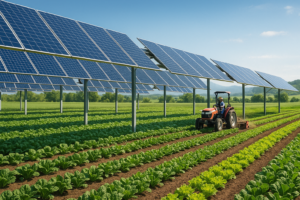AgriSolar: Can Farming and Solar Panels Coexist for Mutual Benefit?
In the face of growing energy demands and climate change concerns, the world is shifting towards sustainable solutions. Among the many innovative approaches, AgriSolar, also known as agrivoltaics, is gaining momentum. But what exactly is AgriSolar, and how does it promise a future where farming and solar energy don’t compete for space but work together?
Let’s explore how this rising concept is reshaping the way we think about land use, renewable energy, and agriculture.
What is AgriSolar?
AgriSolar is the practice of combining solar energy production with agriculture on the same land. It involves the strategic placement of solar panels over croplands or grazing areas, allowing farmers to harvest both food and energy from the same plot.
This dual-use model aims to solve a critical issue: the competition between land for energy infrastructure and land for food production.
The Rising Need for Dual Land Use
Globally, solar installations are expanding rapidly. As solar farms increase, especially in sun-rich agricultural zones, concerns have grown about the loss of arable land. This is where AgriSolar steps in.
Instead of choosing between food or energy, this model allows both reducing land-use conflicts and increasing overall land productivity. Countries like the United States, Germany, Japan, and India are actively experimenting with AgriSolar models, and the early results are promising.
How Does AgriSolar Work?
At first glance, it might seem counterintuitive to install solar panels above crops. After all, wouldn’t the panels block sunlight? Interestingly, research shows that partial shading can actually benefit certain crops.
AgriSolar systems are designed with specific spacing, height, and tilt angles to ensure that:
- Crops receive enough filtered sunlight, preventing overheating and reducing water loss.
- Solar panels are elevated, allowing tractors, workers, and animals to move below them.
- Energy efficiency remains high, even while supporting plant growth beneath.
Some advanced systems even include adjustable panels that track the sun or rotate to let in more light when needed.

Mutual Benefits: Farming and Solar in Harmony
1. Enhanced Land Productivity
Studies have shown that land used for AgriSolar can produce up to 60-80% more total value than land used for farming or solar alone. This is a game-changer in areas where land is scarce or expensive.
2. Improved Crop Yields (in Some Cases)
Certain crops—such as lettuce, spinach, potatoes, and tomatoes—have shown improved growth under partial shade. The cooler, less stressed environment can boost productivity and reduce water needs.
3. Reduced Water Usage
Solar panels reduce evaporation by shading the soil. This means less irrigation is needed, especially in hot and dry regions, helping conserve water—a valuable resource in agriculture.
4. Increased Farmer Income
With AgriSolar, farmers can generate an additional revenue stream by selling electricity back to the grid or entering into lease agreements with solar developers. This financial boost can help small-scale farmers survive uncertain crop seasons.
5. Clean Energy for Rural Communities
Installing solar on farmland also supports decentralized energy production, helping rural areas gain access to affordable, clean power while reducing dependence on fossil fuels.
Challenges to Consider
While AgriSolar sounds like a win-win solution, it’s not without hurdles.
- Initial Investment Costs
Setting up AgriSolar systems is more expensive than traditional solar farms due to the elevated structure and integrated design.
- Crop Selection Matters
Not all crops benefit from partial shade. For instance, crops that require full sunlight (like corn or wheat) might underperform under solar panels.
- Maintenance Complexity
Managing both agricultural and solar systems on the same land requires coordination between farmers and energy operators, which may increase operational complexity.
- Policy and Regulatory Gaps
In many regions, land-use laws haven’t yet caught up with the AgriSolar model, making approvals or subsidies unclear or unavailable.
Real-World Success Stories
Japan has implemented over 2,000 agrivoltaic systems, proving the model works even in densely populated areas.
In India, pilot projects in Maharashtra and Gujarat have shown that combining drip irrigation with solar panel installations leads to significant energy savings for farmers.
Arizona State University (USA) has reported 200% more water efficiency in crops grown under AgriSolar systems compared to open fields.
The Future of AgriSolar
With growing pressure to increase clean energy capacity without harming food security, AgriSolar offers a sustainable and scalable solution. As technology evolves and costs fall, we can expect more farms around the world to integrate solar energy into their landscapes.
Moreover, the future may include AI-based systems that automatically adjust solar panels based on crop needs, sunlight intensity, and weather predictions making this concept even more efficient.
AgriSolar is not just a clever way to share land it’s a vision of harmony between technology and nature. By embracing this model, we can create resilient farming systems, reduce carbon emissions, and make the most of our limited land resources.
As the global demand for both food and clean energy rises, AgriSolar could well be the key to powering a greener, more food-secure future.


 Previous Post
Previous Post Next Post
Next Post